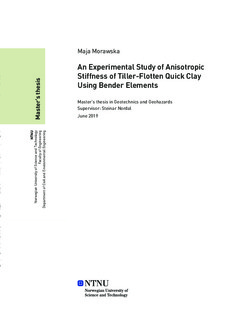| dc.description.abstract | Stiffness anisotropy at small strains is a distinctive feature of many natural soils. The nature of the soil is dependent on the geological processes that occur during soil formation. Stress conditions and depositional environment contribute to the variations of soil properties in different planes, resulting in soil anisotropy. Small strain stiffness anisotropy is crucial in understanding soil behaviour and is widely used in geotechnical numerical modelling. Therefore, there is a need for detailed investigations in this area.
Stiffness anisotropy of quick clay is of particular interest in this study. Due to their low shear strength and extremely high sensitivity, these deposits of sensitive marine clays are extremely challenging in geotechnical engineering. Further analysis on this material is conducted for a stronger understanding of the clay behaviour and to advance the research currently undergoing in the Tiller-Flotten area.
The main objective of this study is to investigate the small strains stiffness anisotropy of Tiller-Flotten quick clay. Using a bender element system, the small strain shear modulus was determined in different planes of the samples. Shear wave velocity measurements were performed on triaxial specimens obtained from mini-block samples. Vertical and horizontal samples were tested with bender elements in an unconfined state and during the consolidation in a triaxial apparatus.
The study results suggest that the Tiller-Flotten quick clay is inherently anisotropic. Shear waves propagate faster in the plane parallel to the bedding plane than in the normal plane. It is therefore concluded, that the stiffness anisotropy is a consequence of the clay’s structure. The cross-anisotropic behaviour of Tiller-Flotten quick clay is however, not conclusively supported by the experimental findings of this study. Further investigations are required to verify this assumption. | |
